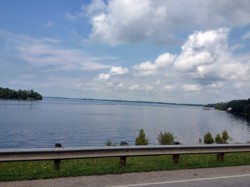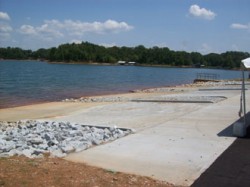DNR Reports High Fish Kill in Parts of Lake Hartwell
 People living and boating on the southern end of Lake Hartwell report seeing large numbers of dead fish washing ashore.
People living and boating on the southern end of Lake Hartwell report seeing large numbers of dead fish washing ashore.
According to the Department of Natural Resources, while some fish die about this time every year on Hartwell Lake, this has been a particularly bad year and more fish than normal are dying.
According to DNR Fisheries Biologist Anthony Rabern, the fish kill this year is unlike anything he has seen in his career.
“We’ve probably lost 1,000 fish already that we know of, but a lot of fish never float to the surface, they just sink, so it could be a lot more.”
Rabern said the fish kill began about two weeks ago and he has been out on the lake several times a week since to monitor the situation. He said all of the fish species in the lake that require cooler water to survive are being affected most, such as Striped Bass, Hybrid Bass, Walleye Pike, and Blueback Herring. 
DNR Law Enforcement officer Craig Fulgum said he receives a number of calls every day from people reporting the dead fish. Most of the fish kill is being seen south of I-85 in the Franklin, Hart, and Stephens County areas of the lake.
“It’s mainly in the southern part of the lake, south of I-85” he said. “We’ve not seen any problems in the northern part of the lake.”
DNR officials blame the high fish kill this year on a lack of cooler water and oxygen in the lower depths of the lake.
“When the Corps pulls out the excess water through their turbines, the majority of that water is coming from the bottom of the lake,” Fulgum said. “But on the bottom (of the lake) is where the thermacline is, and that’s where the cooler water and most of the oxygen is and where the fish operate.”
He said because most of that water being pushed out at a pretty high rate, some parts of the lake have no oxygen at the bottom.
“We’re trying to monitor the situation to figure out how the fish are responding to the very low water quality,” Rabern said. “The other thing it has done with the high rainfall is to force the Corps to release more water than normal. That reduces the amount of cool water in the lake. It’s a dynamic situation and it changes a little bit every day. Conditions are also deteriorating more and more upstream. There’s some suitable habitat upstream, but the fish are not trying to move upstream yet.”
Fulgum said the lack of oxygen and poor water quality is creating a problem for anglers. They’re finding that the usual good fishing spots near the dam and around the southern part of Hartwell Lake are getting harder to find.
“I’ve heard fisherman say they’re looking on their depth finders and there’s no thermacline there,” he said. “Usually there’s about a five to ten foot window where the oxygen is good. You can see it (on the depth finder) like a wall cloud. It’s just a straight line and everything below it has oxygen rich water and that’s where the fish hang out. So as an angler, that’s where you put your line, but right now, that thermacline isn’t there because of the oxygen levels being depleted.”
R abern said when he checked the Hartwell Dam area last week, there were no fish there.
abern said when he checked the Hartwell Dam area last week, there were no fish there.
“We did find last Friday that some fish are still at the fork of the rivers but there is very little oxygen. We’re finding more striper upstream and they’re not usually there this time of year so some are finding that narrow corridor of water necessary for them to survive. Friday we found stripers as high as the Paynes Creek area. Water quality is much better there. If they can find their way up there, more fish will survive. That’s our hope. ”
Rabern said water quality is generally less suitable on the Seneca River arm than the Tugalo River arm and he said that’s where the fish need to head.
“The only refuge I see right now is upstream on the Tugalo River arm. Fish need to get up there to survive. If the surface waters will cool down to about 75 degrees, we will dodge a big bullet and the fish can survive, but right now the surface water is still too warm. ”
Rabern predicted two to three more weeks of fish kill before the cooler weather sets in. That’s when the DNR will be better able to see how the fish have survived and what kind of fishing season can be expected next spring.
“We can mitigate it so some extent with restocking in the spring, but there’s nothing we can do to improve water quality right now. We just have to let the environment take care of that as it will.”
